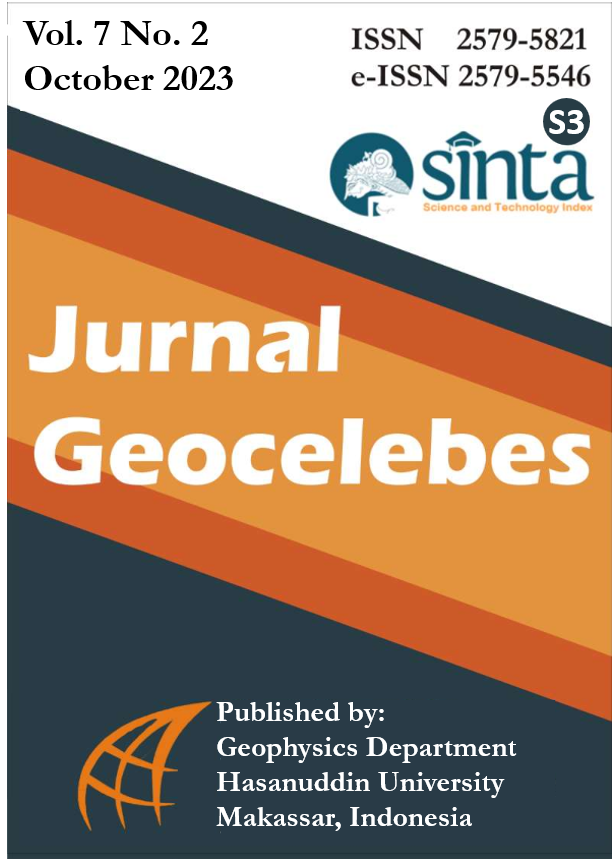Potential of Limestone as a Groundwater Reservoir based on Porosity Analysis in the Tintingon Area, Banggai District
DOI:
https://doi.org/10.20956/geocelebes.v7i2.25258Keywords:
groundwater, limestone, porosity, reservoir, TintingonAbstract
The research area is in Tintingon Village, Banggai Regency, Central Sulawesi Province. This study aims to determine the quality of limestone as a groundwater reservoir based on porosity analysis. This study begins with sampling limestone at seven stations, then selecting fresh samples for laboratory analysis. Laboratory analysis consists of two, namely petrographic analysis and porosity analysis. The petrographic analysis aims to determine the microscopic naming of limestone and the type of pores in the rock. Porosity analysis aims to test the ability of limestone to accommodate fluids as a groundwater reservoir. Based on the petrographic analysis, it is known that the microscopic naming of limestone in the study area is wackestone and packstone. The types of limestone porosity are vug, intercrystal, channel and interparticle. Analysis of limestone porosity in the study area is known to be 15.24% - 29.95%. The porosity value is categorized as good to excellent so the research area is very good as a groundwater reservoir rock.Downloads
References
Ali, M. A. M., & Ahmed, H. M. (2019). Engineering Characteristics of Egyptian Limestone. Mining of Mineral Deposits, 13(2), 75–81. https://doi.org/10.33271/mining13.02.075
Aryaseta, B., Wardhani, P. C., & Zainab, S. (2022). Studi Eksperimental Sifat Fisik dan Mekanik Batu Gamping. KERN: Jurnal Ilmiah Teknik Sipil, 8(1), 37–42.
Choquette, P. W. & Pray, L. C. (1970). Geologic Nomenclature and Classification of Porosity in Sedimentary Carbonates. American Association of Petroleum Geologists Bulletin, 54, 207–250. https://doi.org/10.1306/5D25C98B-16C1-11D7-8645000102C1865D
Corbett, P. W. M., Wang, H., Câmara, R. N., Tavares, A. C., de Almeida, L. F. B., Perosi, F., Machado, A., Jiang, Z., Ma, J., & Bagueira, R. (2017). Using The Porosity Exponent (M) and Pore-Scale Resistivity Modelling to Understand Pore Fabric Types in Coquinas (Barremian-Aptian) of The Morro Do Chaves Formation, NE Brazil. Marine & Petroleum Geology, 88, 628–647. https://doi.org/10.1016/j.marpetgeo.2017.08.032
Dunham, R. J. (1962). Classification of Carbonate Rocks According to Deposition Textures. AAPG Memoir 1.
Eksan, D. H., Zainuri, A. & Kasim, M. (2019). Potensi Batugamping untuk Bahan Baku Industri Semen Daerah Biluhu Timur dan Sekitarnya. Jambura Geoscience Review, 1(2), 68–76. https://doi.org/10.34312/jgeosrev.v1i2.2380
Febriarta, E., Marfai, M. A., Hizbaron, D. R., & Larasati, A. (2020). Kajian Spasial Multi Kriteria DRASTIC Kerentanan Air Tanah Pesisir Akuifer Batugamping di Tanjungbumi Madura. Jurnal Ilmu Lingkungan, 18(3), 476–487. https://doi.org/10.14710/jil.18.3.476-487
He, J., Ding, W., Li, A., Sun, Y., Dai, P., Yin, S., Chen, E., & Gu, Y. (2016). Quantitative Microporosity Evaluation Using Mercury Injection and Digital Image Analysis in Tight Carbonate Rocks: A Case Study from The Ordovician in The Tazhong Palaeouplift, Tarim Basin, NW China. Journal of Natural Gas Science and Engineering, 34, 627–644. https://doi.org/10.1016/j.jngse.2016.07.025
Makhloufi, Y., Collin, P-Y., Bergerat, F., Casteleyn, L., Claes, S., David, C., Menendez, B., Monna, F., Robion, P., Sizun, J-P., Swennen, R., & Rigollet, C. (2013). Impact Of Sedimentology and Diagenesis on The Petrophysical Properties of a Tight Oolitic Carbonate Reservoir. The Case of The Oolithe Blanche Formation (Bathonian, Paris Basin, France). Marine & Petroleum Geology, 48, 323–340. https://doi.org/10.1016/j.marpetgeo.2013.08.021
Matonti, C., Guglielmi, Y., Viseur, S., Bruna, P. O., Borgomano, J., Dahl, C., & Marié, L. (2015). Heterogeneities and Diagenetic Control on The Spatial Distribution of Carbonate Rocks Acoustic Properties at The Outcrop Scale. Tectonophysics, 638, 94–111. https://doi.org/10.1016/j.tecto.2014.10.020
Munawir, A., Jauhari, A., Kurniawan, M. O., & Muhammad, A. N. (2019). Analisis Akuifer Anggota Batugamping Lam Kabeu – Pidie dengan Metode Porositas Sekunder. Prosiding Pendidikan Geografi FKIP UMP, 289–300. https://digitallibrary.ump.ac.id/463/
Nurwaskito, A., Amril, F., & Widodo, S. (2015). Analisis Kualitas Batugamping sebagai Bahan Baku Utama Semen Portland pada PT. Semen Tonasa Provinsi Sulawesi Selatan. Jurnal Geomine, 2(1), 117–123. https://doi.org/10.33536/jg.v2i1.33
Okto, A., Masri, M., Mili, M. Z., & Hasria, H. (2021). Karakteristik Batugamping Formasi Wapulaka dan Pemanfaatannya sebagai Bahan Galian Industri di Desa Wuna, Kabupaten Muna Sulawesi Tenggara. Jurnal Mineral, Energi dan Lingkungan, 5 (1), 11–17. https://doi.org/10.31315/jmel.v5i1.4030
Oyeneyin, B. (2015). Fundamental Principles of Management of Reservoirs with Sanding Problems. Developments in Petroleum Science, 63, 129–138. https://doi.org/10.1016/B978-0-444-62637-0.00003-8
Permana, A. P. (2018). Potensi batugamping terumbu gorontalo sebagai bahan galian industri berdasarkan analisis geokimia XRF. Enviroscienteae, 14 (3), 2302–3708. http://dx.doi.org/10.20527/es.v14i3.5688
Permana, A. P., & Eraku, S. S. (2020). Kualitas batugamping Gorontalo sebagai reservoir air tanah berdasarkan analisis jenis porositas. EnviroScienteae, 16(1), 1–6. http://dx.doi.org/10.20527/es.v16i1.8993
Rusmana, E., Koswara, A. & Simandjuntak, T. O. (1993). Peta Geologi Lembar Luwuk. Pusat Penelitian dan Pengembangan Geologi. Bandung.
Santika, A. W., & Mulyadi, D. (2017). Geokimia Batugamping Daerah Montong, Tuban, Jawa Timur. Riset Geologi dan Pertambangan, 27(2), 227–238. https://jrisetgeotam.lipi.go.id/index.php/jrisgeotam/article/view/493
Todd, D. K. (1980). Groundwater Hydrology. New York. John Wiley and Sons.
Wiloso, D. A., & Ratmy (2018). Analisis Porositas Batugamping Sebagai Akuifer di Desa Ponjong, Kecamatan Ponjong Kabupaten Gunungkidul, Daerah Istimewa Yogyakarta. Jurnal Teknologi, 11(2), 125–132.
Yoanita, G., Mappiratu., & Prismawiryanti. (2016). Kajian sintesis gipsum dari batugamping asal Sulawesi Tengah. Jurnal Riset Kimia Kovalen, 2(1), 39–47. http://jurnal.untad.ac.id/jurnal/index.php/kovalen/article/view/6044
Downloads
Published
How to Cite
Issue
Section
License
Authors who publish with this journal agree to the following terms:
- Authors retain copyright and grant the journal right of first publication with the work simultaneously licensed under a Creative Commons Attribution License that allows others to share the work with an acknowledgement of the work's authorship and initial publication in this journal.
- Authors are able to enter into separate, additional contractual arrangements for the non-exclusive distribution of the journal's published version of the work (e.g., post it to an institutional repository or publish it in a book), with an acknowledgement of its initial publication in this journal.
- Authors are permitted and encouraged to post their work online (e.g., in institutional repositories or on their website) prior to and during the submission process, as it can lead to productive exchanges, as well as earlier and greater citation of published work (See The Effect of Open Access).



